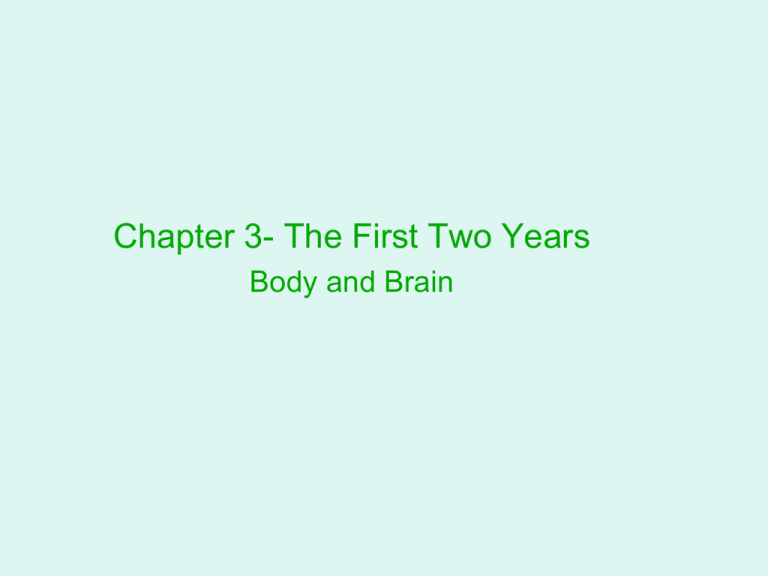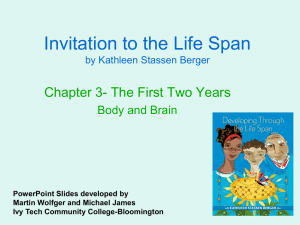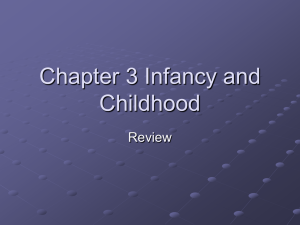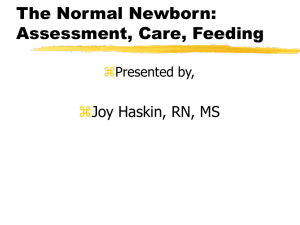Invitation to the Life Span by Kathleen Stassen Berger
advertisement

Chapter 3- The First Two Years Body and Brain Overview: 0-2 • • • • • Amazing Growth Developing Motor and Sensory Skills Health: Immunization, Safety, Nutrition Learning about the World Learning to Talk Body Changes Height and Weight • Average weight at birth: 7.5 pounds • Average length: 20 inches • These numbers are norms, an average measurement. Early Brain Development • Most critical biosocial aspect of growth – newborn’s skull disproportionately large – at birth, 25% of adult brain weight – by age 2, 75% of adult brain weight • Head measurement increases 35% in first year – brain development: changes in the brain’s communication system – Myelination speeds neural impulses about 10 times Head Proportion Body Changes Body Changes Well-baby checkup • Doctor or nurse measures baby’s growth: height, weight, and head circumference. • Abnormal growth may indicate physical or psychological problems. • Headsparing- A biological mechanism that protects the brain when malnutrition disrupts body growth. The brain is the last part of the body to be damaged by malnutrition. Body Changes • Neurons and synapses proliferate (increase rapidly in number) before birth. This increase continues at a fast pace after birth (exuberance), but soon an opposite phenomenon occurs: the elimination, or pruning, of unnecessary connections. • The last part of the brain to mature is the prefrontal cortex, the area for anticipation, planning, and impulse control. • Shaken baby syndrome- a life-threatening injury that occurs when an infant is forcefully shaken back and forth, a motion that ruptures blood vessels in the brain and breaks neural connections. Body Changes • Newborns sleep about 17 hours a day, in one- to three-hour segments. • Newborns’ sleep is primarily active sleep: often dozing, able to awaken if someone rouses them, but also able to go back to sleep quickly if they wake up, cry, and are comforted. • Quiet sleep: slow brain waves and slow breathing • Newborns have a high proportion of REM (rapid eye movement) sleep, with flickering eyes and rapid brain waves. Moving and Perceiving Motor Skills • The first movements are not skills but reflexes, involuntary responses to a particular stimulus. Moving and Perceiving Some reflexes help insure survival: breathing, thrashing, shivering, sucking, rooting, swallowing, spitting up. • • • • • Other reflexes are signs of normal functioning: Babinski reflex. When infants’ feet are stroked, their toes fan upward. Stepping reflex. When infants are held upright with their feet touching a flat surface, they move their legs as if to walk. Swimming reflex. When they are laid horizontally on their stomachs, infants stretch out their arms and legs. Palmar grasping reflex. When something touches infants’ palms, they grip it tightly. Moro reflex. When someone startles them, perhaps by banging on the table they are lying on, infants fling their arms outward and then bring them together on their chests, as if to hold on to something, while crying with wide-open eyes. Moving and Perceiving • Gross motor skills- Physical abilities involving large body movements, such as walking and jumping. • Fine motor skills- Physical abilities involving small body movements, especially of the hands and fingers, such as drawing and picking up a coin. Gross Motor Skills • Involve large muscles and body movements – Hold up torso/head about 4 mos – crawl, creep, walk – Locomotion increases risk of injury (falls/bumps and getting into household chemicals and equipment)- Fine Motor Skills • Small, finely tuned movements, especially of hands and fingers, including – – – – – – successful swiping adjusting reach fingering, pointing, and holding picking up (palmar 2-6 mos; pincer 12+ mos) grasping a moving object transferring objects from hand to hand Moving and Perceiving Moving and Perceiving The sense of hearing develops during the last trimester of pregnancy and is already quite acute at birth; it is the most advanced of the newborn’s senses. Vision is the least mature sense at birth. – Newborns focus only on objects between 4 and 30 inches away. – Binocular vision, the ability to coordinate the two eyes to see one image, appears at 3 months. – Sensation is essential for the visual cortex to develop normally. Tasting, Smelling, and Touching • taste—functions at birth; calmed by sugar, sensitive to sour • touch—comforted by human touch; feel pain • smell—can distinguish between odors and have preferences • Early sensation is organized for – social interaction – comfort Surviving in Good Health Preventing Sudden Infant Death Syndrome • In 1990, about 5,000 babies died of sudden infant death syndrome (SIDS) in the United States. • The actual cause of SIDS is still unknown: low birthweight, heavy clothing, soft bedding, teenage parenthood, and, particularly, maternal smoking are risk factors. • Putting infants to sleep on their backs reduces the risk but does not eliminate it. Surviving in Good Health Adequate Nutrition • For every infant disease (including SIDS), breast-feeding reduces risk and malnutrition increases it, stunting growth of body and brain. • Breastfed babies are less likely to develop allergies, asthma, obesity, and heart disease. • As the infant gets older, the composition of breast milk adjusts to the baby’s changing nutritional needs. Nutrition: Breast Is Best • Breast Milk - begins with colostrum, high-calorie nourishment before milk “lets down” - easily digestible - has antibodies and antibacterial properties - better for baby’s health • Bottle Feeding - better option if mother is HIV-positive or using drugs - Babies more likely to have allergies • Feed on demand Why “Breast is Best” • The nutritional composition of breast milk is ideal for human infants. • As the baby grows and its nutritional needs change, mother’s milk adapts to meet these needs. • Breast milk is easily digested. • Breastfeeding promotes attachment (close nurturing bond). Why “Breast is Best” • Breastfeeding reduces the incidence & severity of diseases, infections some chronic diseases. • Breastfeeding enhances brain development. • Breastfeeding helps reduce the possibility of SIDS. Why “Breast is Best” • Breastfeeding reduces postpartum bleeding and aids involution (uterus returning to normal size). • Breastfeeding the risk of breast cancer & ovarian cancer for the mother. • Breastfeeding mothers have fewer hip fractures in the postmenopausal period than women who have never breastfed. Infant Cognition Piaget • sensorimotor intelligence – Piaget’s term for the way infants think—by using their senses and motor skills—during the first period of cognitive development. • assimilation – Piaget’s term for a type of adaptation in which new experiences are interpreted to fit into, or assimilate with, old ideas. • accommodation – Piaget’s term for a type of adaptation in which old ideas are restructured to include, or accommodate, new experiences. • object permanence – The realization that objects (including people) still exist when they can no longer be seen, touched, or hear. (8 months) Infant Cognition Infant Cognition Information-processing Theory • A perspective modeled on computer functioning. • Information-processing theorists believe that a step-by-step description of the mechanisms of thought adds insight to our understanding of cognition at every age. • Information-processing research has overturned some of Piaget’s conclusions— including the concept of object permanence. Infant Cognition • The visual cliff was designed to provide the illusion of a sudden dropoff between one horizontal surface and another. • Mothers were able to urge their 6-montholds to wiggle forward over the supposed edge of the cliff, but 10-month-olds fearfully refused to budge. Infant Cognition Early Memory • According to classic developmental theory, infants store no memories in their first year. • Developmentalists now agree that very young infants can remember if the following conditions are met: – Experimental conditions are similar to real life. – Motivation is high. – Special measures aid memory retrieval. Language Learning Early Communication • Child-directed speech- The high-pitched, simplified, and repetitive way adults speak to infants. (Also called baby talk or motherese.) • Babbling- The extended repetition of certain syllables, such as ba-ba-ba, that begins when babies are between 6 and 9 months old. • Naming explosion- A sudden increase in an infant’s vocabulary, especially in the number of nouns, that begins at about 18 months of age. Language Learning First Words • At about 1 year, babies speak a few words. First words (2 new/week); common in US: ball, dadddy, book, go, no, up • Spoken vocabulary increases gradually (about one or two new words a week). • Once spoken vocabulary reaches about 50 words, it builds quickly, at a rate of 50 to 100 words per month. Language Learning • Holophrase- A single word that is used to express a complete, meaningful thought. All new talkers say names and utter holophrases. • Infants differ in their use of various parts of speech, depending on the language they are learning, e.g. more nouns and fewer verbs. • Naming explosion - sudden increase in infant vocabulary, especially nouns, beginning at 18 months (9/day) • Pivot words used in 1st 2 word phrases (no up, no cup) Language Learning Acquiring Grammar • Grammar includes all the devices by which words communicate meaning: sequence, prefixes, suffixes, intonation, loudness, verb forms, pronouns, negations, prepositions, and articles. • Worldwide, people who are not yet 2 years old already use language well. Language Learning Theories Learning Approach: Infants need to be taught • B. F. Skinner (1957) noticed that spontaneous babbling is usually reinforced. • Parents are expert teachers, and other caregivers help them teach children to speak (high pitch, simple vocab., short sentences, repetition, more questions & commands) • Frequent repetition of words is instructive, especially when the words are linked to the pleasures of daily life. • Well-taught infants become well-spoken children. Language Learning Theories Language Learning is Innate • Language acquisition device (LAD)Chomsky’s term for a hypothesized mental structure that enables humans to learn language, including the basic aspects of grammar, vocabulary, and intonation. Language Learning Theories Social Impulse Toward Communication • Infants communicate in every way they can because humans are social beings, dependent on one another for survival, well-being, and joy. • Infants seek to respond by vocalizing, babbling, gesturing, listening, & pointing Why Sign? • Deaf children (whose parents sign to them) produce first words before hearing children • Gross motor movements develop before fine motor skills • Signing takes advantage of natural gestures (wave, clap) Why Sign? (2) (Research on using signs with young children) • Enhances communication (Lindert, 2001) • Linguistically & cognitively advanced at age 4 (Goodwyn, Acredolo & Brown, 2000) • Less frustration & aggressive behavior (Grabmeier, 1999) • Enhanced vocabulary, spelling and reading skills (Daniels, 2001) Why Sign? (3) (Effects of signing on school-aged children) • Children’s ability to integrate language with gestures is positively related to their literacy skills (Anthony, 2002). • Advanced phonemic & metalinguistic awareness (Anthony & Lindert, in press) • Average IQ advantage of 12 points (Acredolo & Goodwyn, 2000) Avoid Tantrums Tantrums occur… • Out of frustration • When child is unable to communicate needs/desires Signing allows… • Communication before speech • Manners • A way to halt bad behavior • Silent or private communication







